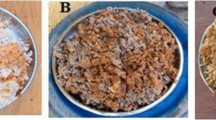Abstract
Investigation of the optimum conditions for the combined application of Saccharomyces sp. (yeast) and Leuconostoc sp. (lactic acid bacteria, LAB) isolated in a previous study to the development of novel sourdough was carried out by response surface analysis. First, the cell growth conditions were analyzed. LAB showed good proliferation under conditions of 30–35°C, low pH, and high acidity, whereas the growth of yeast was inhibited. The growth of yeast was optimum at 25°C for 24 h. Based on these results, analysis of sourdough was carried out by varying the LAB population, temperature, and time after fixing the number of yeast. It was determined by response surface analysis that the optimal conditions for fermentation are LAB population of 105 CFU/mL, temperature of 25°C, and reaction time of 24 h. From these results, the growth of LAB should be constantly maintained, and an appropriate pH that does not inhibit the growth of yeast due to the presence of generated organic acid is required to allow for the unique properties of sourdough. This study could give useful information for the development of novel sourdough.
Similar content being viewed by others
References
Danaka KB. Science of Baking Process. Kwang Lim Publisher, Tokyo, Japan. pp. 151–158 (1994)
Hong JH, Kim KJ. Effect of prepared by Enterococcus sp. and Lactobacillus sp. on the quality of barley bread: Identification of bacterial strain from barley power and rheological properties of sourdough. Korean J. Diet. Culture 16: 354–360 (2001)
Hong JH, Kim KJ. Effect of barley bread using sourdough prepared by Enterococcus sp. and Lactobacillus sp.: Physicochemical and rheological properties of barley bread. Korean J. Diet. Culture 16: 361–370 (2001)
Hong JH, Kim KJ, Bang KS. Effect of sourdough starter on the characteristics of rheological of barley bread. Korean J. Soc. Food Sci. 16: 358–362 (2000)
Corsetti A, Gobbetti M, Rossi J, Damiani P. Antimould activity of sourdough lactic acid bacteria: Identification of a mixture of organic acids produced by Lactobacillus sanfrancisco CB1. Appl. Microbiol. Biot. 50: 253–256 (1998)
Messens W, Vuyst LD. Inhibitory substance produced by Lactobacilli isolated from sourdough-A review. Int. J. Food Microbiol. 72: 31–43 (2002)
Linko YY, Javanainen P, Linko S. Biotechnology of bread baking. Trends Food Sci. Tech. 8: 339–344 (1997)
Corsetti A, Gobbetti M, Smacchi E. Antibacterial activity of sourdough lactic acid bacteria: Isolation of a bacteriocin like inhibitory substance from Lactobacillus sanfrancisco C57. Food Microbiol. 13: 447–456 (1996)
Todorov S, Onno B, Sorokine O, Chobert JM, Ivanova I, Dousset X. Detection and characterization of a novel antibacterial substance produced by Lactobacillus plantarum ST 31 isolated from sourdough. Int. J. Food Microbiol. 48: 167–177 (1999)
Gullo M, Romano AD, Pulvirenti A, Giudici P. Candida humilis-dominant species in sourdoughs for the production of durum wheat bran flour bread. Int. J. Food Microbiol. 80: 55–59 (2002)
Gobbetti M. The sourdough microflora: Interactions of lactic acid bacteria and yeasts. Trends Food Sci. Tech. 9: 267–274 (1998)
Ganzle MG, Ehmann M, Hammes WP. Modeling of growth of Lactobacillus sanfrancisco and Candida milleri in response to process parameters of sourdough fermentation. Appl. Environ. Microb. 64: 2616–2623 (1998)
Corsetti A, Gobbetti M, Balestrieri F, Paoletti F, Russi L, Rossi J. Sourdough lactic acid bacteria effects on bread firmness and staling. J. Food Sci. 63: 347–351 (1998)
Wang HL, Karidej L, Hesseltine CW. Lactic acid fermentation of soybean milk. J. Milk Food Technol. 37: 71–73 (1974)
Kim KH, Ko YT. Study on growth and acid production by lactic acid bacteria in soy milk. Korean J. Food Sci. Technol. 19: 151–156 (1987)
Martinez AMA, Pitarch B, Bayarri P, Benedito DBC. Microflora of the sourdough of wheat flour bread. Cereal Chem. 67: 85–91 (1990)
Sugihara TF, Kline N, Miller MW. Microoganisms of the San Francisco sourdough bread process. Appl. Microbiol. 21: 456–458 (1971)
Kook SU. Development of starter cultures for the extension of the shelf life of bread. Korean J. Food Nutr. 9: 236–241 (1996)
Ha SD. Evaluation of dry film method for isolation of microorganism from foods. Korean J. Appl. Microbiol. Biotechnol. 24: 174–184 (1996)
Choi KS, Choi C, Im MH, Choi JD, Chung HC, Kim YH, Lee CW. The effects of soybean boiling waste liquor on the enhancement of lactic acid fermentation during Korean traditional ganjang mash maturing. Agr. Chem. Biotechnol. 41: 201–207 (1998)
Sung NK. SAS/STAT-Analysis of Dispersion. Jayoo Academy Publisher, Seoul, Korea. pp. 93–105 (1993)
Sung NK. SAS/STAT-Analysis of Regression, Jayoo Academy Publisher, Seoul, Korea. pp. 201–238 (1993)
Sung NK. SAS/GRAPH-Statistical Graphics, Jayoo Academy Publisher, Seoul, Korea. pp. 219–261 (1993)
Collar C, Andreu P, Martinez JC, Aremero E. Optimization of hydrocolloid addition to improve wheat bread dough functionality: A response surface methodology study. Food Hydrocolloid. 13: 467–475 (1999)
Oh YK, Kim CS, Chang DJ. Optimization of steamed bread making with addition green tea powder using response surface methodology. J. Korean Soc. Food Sci. Nutr. 31: 451–459 (2002)
Jeong YJ, Lee MH, Lee GD, Seo JH, Kim OM. Establishment on preparation condition of pumpkin honey gochujang by response surface methodology. J. Korean Soc. Food Sci. Nutr. 30: 1102–1107 (2001)
Kim KJ, Chung HC, Kwon OJ. Characteristics of culture and isolating lactic acid bacteria and yeast from sourdough. J. Korean Soc. Food Sci. Nutr. 33: 1180–1185 (2004)
Meignen B, Onno B, Gelinas P, Infantes M, Guilois S, Cahagnier B. Optimization of sourdough fermentation with Lactobacilli brevis and baker’s yeast. Food Microbiol. 18: 239–245 (2001)
Guyot JP, Calderon M, Morlon-Guyot J. Effect of pH control on lactic acid fermentation of starch by Lactobacillus manihotivorans LMG 18010T. J. Appl. Microbiol. 88: 176–182 (2000)
Meuser F, Barber B, Fisher G. Determination of the microbial activity of dried sourdoughs by revitalization of their lactic acid bacteria and yeasts. Food Control 6: 147–154 (1995)
Author information
Authors and Affiliations
Corresponding author
Rights and permissions
About this article
Cite this article
Chung, HC., Jeong, B.Y. & Han, G.D. Optimum conditions for combined application of Leuconostoc sp. and Saccharomyces sp. to sourdough. Food Sci Biotechnol 20, 1373–1379 (2011). https://doi.org/10.1007/s10068-011-0189-0
Received:
Revised:
Accepted:
Published:
Issue Date:
DOI: https://doi.org/10.1007/s10068-011-0189-0




